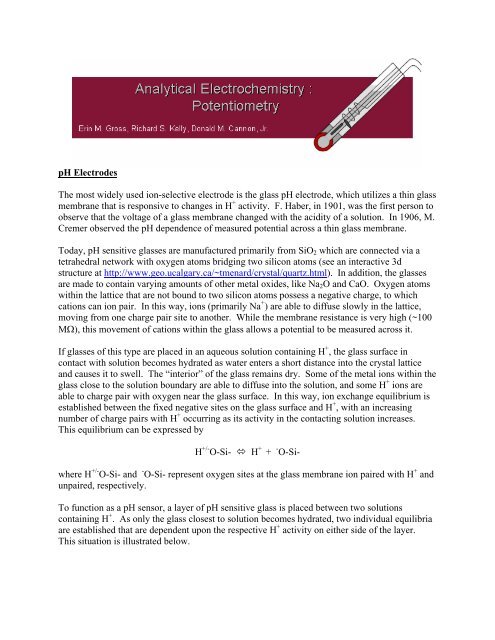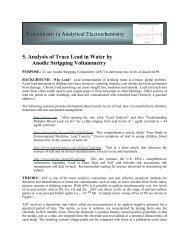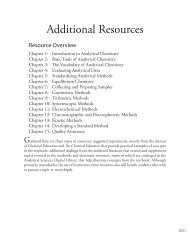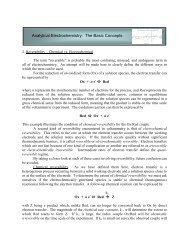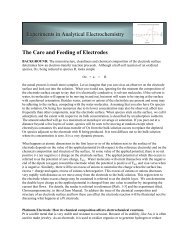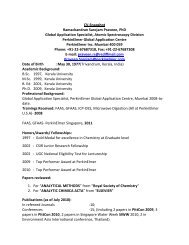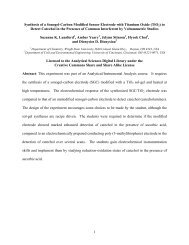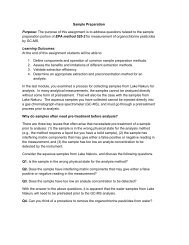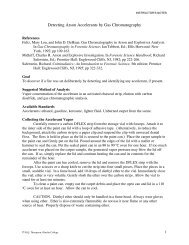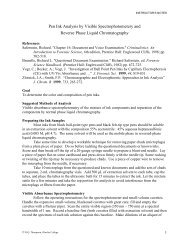pH Electrodes The most widely used ion-selective electrode is the ...
pH Electrodes The most widely used ion-selective electrode is the ...
pH Electrodes The most widely used ion-selective electrode is the ...
You also want an ePaper? Increase the reach of your titles
YUMPU automatically turns print PDFs into web optimized ePapers that Google loves.
<strong>pH</strong> <strong>Electrodes</strong><strong>The</strong> <strong>most</strong> <strong>widely</strong> <strong>used</strong> <strong>ion</strong>-<strong>selective</strong> <strong>electrode</strong> <strong>is</strong> <strong>the</strong> glass <strong>pH</strong> <strong>electrode</strong>, which utilizes a thin glassmembrane that <strong>is</strong> responsive to changes in H + activity. F. Haber, in 1901, was <strong>the</strong> first person toobserve that <strong>the</strong> voltage of a glass membrane changed with <strong>the</strong> acidity of a solut<strong>ion</strong>. In 1906, M.Cremer observed <strong>the</strong> <strong>pH</strong> dependence of measured potential across a thin glass membrane.Today, <strong>pH</strong> sensitive glasses are manufactured primarily from SiO 2 which are connected via atetrahedral network with oxygen atoms bridging two silicon atoms (see an interactive 3dstructure at http://www.geo.ucalgary.ca/~tmenard/crystal/quartz.html). In addit<strong>ion</strong>, <strong>the</strong> glassesare made to contain varying amounts of o<strong>the</strong>r metal oxides, like Na 2 O and CaO. Oxygen atomswithin <strong>the</strong> lattice that are not bound to two silicon atoms possess a negative charge, to whichcat<strong>ion</strong>s can <strong>ion</strong> pair. In th<strong>is</strong> way, <strong>ion</strong>s (primarily Na + ) are able to diffuse slowly in <strong>the</strong> lattice,moving from one charge pair site to ano<strong>the</strong>r. While <strong>the</strong> membrane res<strong>is</strong>tance <strong>is</strong> very high (~100MΩ), th<strong>is</strong> movement of cat<strong>ion</strong>s within <strong>the</strong> glass allows a potential to be measured across it.If glasses of th<strong>is</strong> type are placed in an aqueous solut<strong>ion</strong> containing H + , <strong>the</strong> glass surface incontact with solut<strong>ion</strong> becomes hydrated as water enters a short d<strong>is</strong>tance into <strong>the</strong> crystal latticeand causes it to swell. <strong>The</strong> “interior” of <strong>the</strong> glass remains dry. Some of <strong>the</strong> metal <strong>ion</strong>s within <strong>the</strong>glass close to <strong>the</strong> solut<strong>ion</strong> boundary are able to diffuse into <strong>the</strong> solut<strong>ion</strong>, and some H + <strong>ion</strong>s areable to charge pair with oxygen near <strong>the</strong> glass surface. In th<strong>is</strong> way, <strong>ion</strong> exchange equilibrium <strong>is</strong>establ<strong>is</strong>hed between <strong>the</strong> fixed negative sites on <strong>the</strong> glass surface and H + , with an increasingnumber of charge pairs with H + occurring as its activity in <strong>the</strong> contacting solut<strong>ion</strong> increases.Th<strong>is</strong> equilibrium can be expressed byH +/- O-Si- H + + - O-Si-where H +/- O-Si- and - O-Si- represent oxygen sites at <strong>the</strong> glass membrane <strong>ion</strong> paired with H + andunpaired, respectively.To funct<strong>ion</strong> as a <strong>pH</strong> sensor, a layer of <strong>pH</strong> sensitive glass <strong>is</strong> placed between two solut<strong>ion</strong>scontaining H + . As only <strong>the</strong> glass closest to solut<strong>ion</strong> becomes hydrated, two individual equilibriaare establ<strong>is</strong>hed that are dependent upon <strong>the</strong> respective H + activity on ei<strong>the</strong>r side of <strong>the</strong> layer.Th<strong>is</strong> situat<strong>ion</strong> <strong>is</strong> illustrated below.
SiliconOxygenH +Na +Hydrated glassDry glassInnersolut<strong>ion</strong>Outersolut<strong>ion</strong>A difference in <strong>the</strong> H + activities on ei<strong>the</strong>r side of <strong>the</strong> glass membrane leads to a difference in <strong>the</strong>number of <strong>ion</strong> pairs that ex<strong>is</strong>t, and an imbalance in <strong>the</strong> surface charge between <strong>the</strong> hydratedlayers. Th<strong>is</strong> results in a membrane potential that <strong>is</strong> <strong>pH</strong> dependent, described according to <strong>the</strong>Nernst equat<strong>ion</strong>E membrane = E inner – E outer = 0.0592 log [(A inner ) / (A outer )]where E inner and E outer are <strong>the</strong> surface potentials on ei<strong>the</strong>r side of <strong>the</strong> membrane, and A inner andA outer represent <strong>the</strong> H + activities of <strong>the</strong> inner and outer solut<strong>ion</strong>s, respectively.Most commonly, <strong>pH</strong> <strong>electrode</strong>s are of a combinat<strong>ion</strong> design, in which <strong>the</strong> glass membrane and<strong>the</strong> necessary reference <strong>electrode</strong>s are incorporated into <strong>the</strong> same <strong>electrode</strong> body. A figure of atypical combinat<strong>ion</strong> <strong>pH</strong> <strong>electrode</strong> <strong>is</strong> shown on <strong>the</strong> next page.(http://upload.wikimedia.org/wikipedia/commons/e/e9/Glass_<strong>electrode</strong>_scheme.jpg)
<strong>electrode</strong> barrelouter reference <strong>electrode</strong>porous fritreference fill solut<strong>ion</strong>internal reference <strong>electrode</strong>internal fill solut<strong>ion</strong>, fixed H + activity<strong>pH</strong> sensitive glass membranehttp://upload.wikimedia.org/wikipedia/commons/e/e9/Glass_<strong>electrode</strong>_scheme.jpgIn th<strong>is</strong> design, <strong>the</strong> inner fill solut<strong>ion</strong> contacting <strong>the</strong> glass membrane contains a fixed activity ofH + . Typically, a Ag/AgCl reference <strong>electrode</strong> <strong>is</strong> in contact with th<strong>is</strong> inner solut<strong>ion</strong>, and <strong>the</strong>solut<strong>ion</strong> contains 0.1 M HCl saturated with AgCl. A second Ag/AgCl reference <strong>electrode</strong> <strong>is</strong>located within a solut<strong>ion</strong> compartment surrounding <strong>the</strong> inner solut<strong>ion</strong> compartment. Th<strong>is</strong>solut<strong>ion</strong> <strong>is</strong> in contact with <strong>the</strong> external solut<strong>ion</strong> of unknown H + activity through a porous frit on<strong>the</strong> side of <strong>the</strong> <strong>electrode</strong> barrel.<strong>The</strong> combinat<strong>ion</strong> <strong>electrode</strong> allows <strong>the</strong> measurement of both <strong>the</strong> inner and <strong>the</strong> outer membranesurface potentials, which as we saw above, <strong>is</strong> related to <strong>the</strong> solut<strong>ion</strong> <strong>pH</strong> by <strong>the</strong> Nernst equat<strong>ion</strong>.<strong>The</strong> <strong>the</strong>oretical potential across <strong>the</strong> glass membrane changes by 59.2 mV for each unit change insolut<strong>ion</strong> <strong>pH</strong>. A combinat<strong>ion</strong> <strong>electrode</strong> cell can be represented by <strong>the</strong> shorthand notat<strong>ion</strong> below.glass membraneinside glassoutside glassAg (s)| AgCl (s)| Cl - (aq)|| H + (aq, unknown)|| H + (aq, fixed) , Cl- (aq) | AgCl (s)| Ag (s)outer reference <strong>electrode</strong>porous fritinternal reference <strong>electrode</strong>Practical considerat<strong>ion</strong>s. <strong>The</strong> potential measured by a <strong>pH</strong> indicator <strong>electrode</strong> includes not only<strong>the</strong> desired membrane or boundary potential, but also small contribut<strong>ion</strong>s from what are knownas junct<strong>ion</strong> potentials and asymmetry potentials. Junct<strong>ion</strong> potential has been described in aseparate sect<strong>ion</strong> of th<strong>is</strong> module, and for <strong>the</strong> specific case of <strong>the</strong> combinat<strong>ion</strong> <strong>pH</strong> <strong>electrode</strong> <strong>is</strong> thatwhich develops across <strong>the</strong> porous frit separating <strong>the</strong> second reference <strong>electrode</strong> from <strong>the</strong> externalmeasured solut<strong>ion</strong>. Asymmetry potentials result from physical differences between <strong>the</strong> inner andouter surfaces of <strong>the</strong> glass membrane, leading to different inner and outer potentials for <strong>the</strong> sameH + activity. Correct<strong>ion</strong>s for <strong>the</strong>se small potential errors can be made by frequent calibrat<strong>ion</strong> of<strong>the</strong> glass <strong>electrode</strong> in standard solut<strong>ion</strong>s covering <strong>the</strong> <strong>pH</strong> range in which measurements aredesired.
Users of glass <strong>pH</strong> <strong>electrode</strong>s should also be aware of alkaline and acid errors that limit <strong>the</strong> <strong>pH</strong>range over which effective measurements can be made. At very high <strong>pH</strong>, generally > 10, <strong>most</strong>glass <strong>electrode</strong>s become responsive to both H + and Na + , with <strong>the</strong> measured <strong>pH</strong> being lower thanactual. At low <strong>pH</strong>, typically < 1, glass membranes are susceptible to saturat<strong>ion</strong> by H + , andproduce <strong>pH</strong> readings that are higher than actual. Specialty glasses are available that minimize<strong>the</strong>se errors if routine measurements must be made at <strong>the</strong>se <strong>pH</strong> extremes.Solid state <strong>pH</strong> sensors. For many applicat<strong>ion</strong>s, such as those requiring ruggedness andminiaturizat<strong>ion</strong>, a thin glass membrane <strong>is</strong> impractical as a <strong>pH</strong> sensor. Alternatives to <strong>the</strong> glass<strong>electrode</strong> include <strong>the</strong> ISFET, or <strong>ion</strong> <strong>selective</strong> field effect trans<strong>is</strong>tor. More informat<strong>ion</strong> on solidstate <strong>electrode</strong>s can be found at http://www.ph-meter.info/<strong>pH</strong>-<strong>electrode</strong>-solid-state,http://www.ewh.ieee.org/tc/sensors/Tutorials/ISFET-Bergveld.pdf, andhttp://csrg.ch.pw.edu.pl/tutorials/<strong>is</strong>fet (accessed 7/28/2008).


